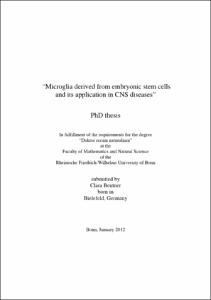Beutner, Clara: Microglia derived from embryonic stem cells and its application in CNS diseases. - Bonn, 2012. - Dissertation, Rheinische Friedrich-Wilhelms-Universität Bonn.
Online-Ausgabe in bonndoc: https://nbn-resolving.org/urn:nbn:de:hbz:5n-29334
Online-Ausgabe in bonndoc: https://nbn-resolving.org/urn:nbn:de:hbz:5n-29334
@phdthesis{handle:20.500.11811/5354,
urn: https://nbn-resolving.org/urn:nbn:de:hbz:5n-29334,
author = {{Clara Beutner}},
title = {Microglia derived from embryonic stem cells and its application in CNS diseases},
school = {Rheinische Friedrich-Wilhelms-Universität Bonn},
year = 2012,
month = aug,
note = {Microglia are the resident immune cells of the central nervous system (CNS). They are known to have detrimental as well as beneficial effects. To overcome the limitations of primary microglia, embryonic stem cell derived microglia precursor cells (ESdM) were differentiated out of mouse embryonic stem cells. ESdM showed expression of microglial markers such as Iba1, CD45 or CD68, but lacked stem cell markers. Stimulation of ESdM with Interferon-γ (IFN- γ) or lipopolysaccharides leads to an up-regulation of inflammatory cytokines and to increased phagocytosis. Furthermore, ESdM migrate in a dose-dependent manner towards fractalkine CX3CL1. Gene expression of ESdM resembles that of primary microglia and preliminary data indicate that they can be subpolarized into a neuro-toxic or a neuro-protective subtype by IFN-γ or interleukin-4.
After lentiviral transduction of ESdM with Neurotrophin 3 (NT3), they were applied to experimental autoimmune encephalomyelitis (EAE) afflicted mice to reveal possible therapeutic chances for the treatment of multiple sclerosis (MS). EAE mice treated with NT3-green fluorescent protein (GFP)-ESdM showed stable recovery of clinical symptoms, accompanied by less demyelination and less axonal damage in the spinal cord tissue. ESdM migrated to the lesions and promoted an anti-inflammatory cytokine profile. Furthermore, in close proximity to the NT3-GFP-ESdM, the axonal growth protein GAP-43 could be found, indicating neural regeneration due to the presence of NT3. To summarize, NT3-GFP-ESdM can be considered a promising tool for therapeutic approaches to EAE as a model of MS.
ESdM were also applied in co-culture systems with glioma cells to determine their potential for therapeutical approaches. ESdM phagocytosed glioma cells and reduced glioma cell number in vitro. Phagocytosis and proliferation inhibition were enhanced through subpolarization of ESdM into M1 subtype. The anti-tumor effects were most likely mediated via DAP12 and the DAP12-associated receptors SiglecH and Trem2. Knockdown of these molecules decreased the anti-tumor activity of ESdM, while overexpression of DAP12 resulted in stronger anti-tumor effects. Thus, ESdM could provide functions to also fight glioma in vivo.
In summary, ESdM might provide a broad range of possible applications in therapeutical approaches of CNS diseases.},
url = {https://hdl.handle.net/20.500.11811/5354}
}
urn: https://nbn-resolving.org/urn:nbn:de:hbz:5n-29334,
author = {{Clara Beutner}},
title = {Microglia derived from embryonic stem cells and its application in CNS diseases},
school = {Rheinische Friedrich-Wilhelms-Universität Bonn},
year = 2012,
month = aug,
note = {Microglia are the resident immune cells of the central nervous system (CNS). They are known to have detrimental as well as beneficial effects. To overcome the limitations of primary microglia, embryonic stem cell derived microglia precursor cells (ESdM) were differentiated out of mouse embryonic stem cells. ESdM showed expression of microglial markers such as Iba1, CD45 or CD68, but lacked stem cell markers. Stimulation of ESdM with Interferon-γ (IFN- γ) or lipopolysaccharides leads to an up-regulation of inflammatory cytokines and to increased phagocytosis. Furthermore, ESdM migrate in a dose-dependent manner towards fractalkine CX3CL1. Gene expression of ESdM resembles that of primary microglia and preliminary data indicate that they can be subpolarized into a neuro-toxic or a neuro-protective subtype by IFN-γ or interleukin-4.
After lentiviral transduction of ESdM with Neurotrophin 3 (NT3), they were applied to experimental autoimmune encephalomyelitis (EAE) afflicted mice to reveal possible therapeutic chances for the treatment of multiple sclerosis (MS). EAE mice treated with NT3-green fluorescent protein (GFP)-ESdM showed stable recovery of clinical symptoms, accompanied by less demyelination and less axonal damage in the spinal cord tissue. ESdM migrated to the lesions and promoted an anti-inflammatory cytokine profile. Furthermore, in close proximity to the NT3-GFP-ESdM, the axonal growth protein GAP-43 could be found, indicating neural regeneration due to the presence of NT3. To summarize, NT3-GFP-ESdM can be considered a promising tool for therapeutic approaches to EAE as a model of MS.
ESdM were also applied in co-culture systems with glioma cells to determine their potential for therapeutical approaches. ESdM phagocytosed glioma cells and reduced glioma cell number in vitro. Phagocytosis and proliferation inhibition were enhanced through subpolarization of ESdM into M1 subtype. The anti-tumor effects were most likely mediated via DAP12 and the DAP12-associated receptors SiglecH and Trem2. Knockdown of these molecules decreased the anti-tumor activity of ESdM, while overexpression of DAP12 resulted in stronger anti-tumor effects. Thus, ESdM could provide functions to also fight glioma in vivo.
In summary, ESdM might provide a broad range of possible applications in therapeutical approaches of CNS diseases.},
url = {https://hdl.handle.net/20.500.11811/5354}
}






